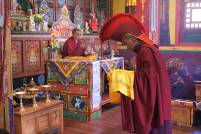The annual festival cycle of the Sherpas
The periods for calendric festivals are fixed based on the Tibetan lunar calendar. The main rituals thus fall approximately into the following solar months but may change somehow depending on the Tibetan lunar calendar.
February: Losar (Tibetan New Year), in 2019 year of the female earth pig. Kangyur rituals, i.e. reading of texts from the Kangyur books, are conducted, offerings of conical ritual figures (torma) made of dough are presented to the deities protecting the monasteries and to the higher and lower deities of the locality to achieve their protection for the village in the coming year. At the end of the festival a big rite of food offerings (tsog) is held for the village at large where each visitor will receive a bag of snacks/food which are believed to contain the blessing of the high gods attending the ritual. In the private households, villagers will prepare a soup called gutok. On the third or 15th day after Losar, the Yulsang („valley sang offering”) is conducted by neighbors on pastures near the village. The high gods and the deities of the locality (lu sadag) and those protecting the valley (yulha) are invited to take place in the ritual dough figures (torma) of a nature altar constructed in a bamboo or stone fenced place. The ceremony celebrates the unity of the neighborhood (yulowa) and culminates in a smoke offering (sang) and feast held together at the event (Mühlich 1996: 172-176).
April: The Dumji (Dub-Chho) festival is held for a period of five days, culminating in a cham dance accompanied by loud instrumental music from horns, brass instruments and drums. The ceremonial dancers represent tantric lamas or protector gods and deities of the locality. At the fourth day, the harmful forces are tamed or destroyed in an exorcist rite, depending on the yearly cycle. On the last day, visitors will attend the ceremony to receive the blessing of „long life “(tse wang) as well as the offering of blessed food (tsog). The festival carries several meanings (see Berg 2008), including „group sadhana practice “(drub-chen), when reading of texts and visualization of the gods is the focus during the first three days. Especially the last days relate to the meaning of achieving the blessing of fertility, achieving rain and growth for the crops and to attain protection from harmful forces. According to Paul (1979: 278) the „festival forms the climax of the Sherpas‘ annual village ceremonial cycle“.
May: The Nyungne festival is held for a period of four days. It differs from other festivals in that attending the festival is rather individual and not a „duty“. It provides the opportunity to purify oneself from sin (digpa) and to achieve good Karma (phayen). The ritual deems participants to abolish for sins, to be humble and to practice this attitude by bowing down repeatedly and by fasting during the period of the ritual. The ritual is devoted to the god Phakpa Chenrezig (Ortner 1978: 36), a form of Avalokitesvara, who symbolizes compassion for all living beings. Under the name Choki Gyalpo, the same god, however, may attain the form of accountant or judge of sins. As the other main rituals, also the Nyungne ritual is completed with an offering of blessed food (tsog) for all villagers on the last day.
July: Yerchod („summer offering ceremony “), locally also known as Yershang, is conducted by neighbors on the high pastures. It is also held to celebrate the middle of the year and is part of the rituals conducted by households who are still involved in the seasonal economy of herding tsauri and yak.
November / December: The big festival of Mani Rimdu (Mani Rildub) is celebrated in some monasteries. It is like the Dumji Festival but usually only held in monasteries of the celibate monastic order. Also, there are dancers embodying the high gods and staging a fight against demons. At the end there is an exorcist rite to defend the harmful forces. Villagers visit the monasteries and emotionally take part in the performance of the ritual (Ortner 1978: 130). As the other main rituals, also the Mani Rimdu ritual is completed with an offering of blessed food (tsog) for all people attending the ritual on the last day.
Bibliography:
Berg, Eberhard 2008: The Sherpa Dumji Masked Dance Festival. An ethnographic description of the ‘great liturgical performance’ as celebrated annually according to the tradition of the Lamaserwa in the village temple of Gompa Zhung, Solu. Lumbini International Research Institute.
Fürer-Haimendorf, Christoph von 1984: The Sherpas Transformed: Social Change in a Buddhist Society of Nepal. New Delhi.
Mühlich, Michael 1996: Traditionelle Opposition: Individualität und Weltbild der Sherpa. Pfaffenweiler.
Ortner , Sherry B. 1978: Sherpas Through Their Rituals. Cambridge.
Paul, R. 1979: Dumje: Paradox and Resolution in Sherpa Ritual Symbolism. In American Ethnologist 6(2): 274-304.
Zimmermann, Ronald 2017: Bedeutung der Feste und Rituale für die Gemeinschaft der Sherpas. In Nepal-I 115 (2016): 69-75.
